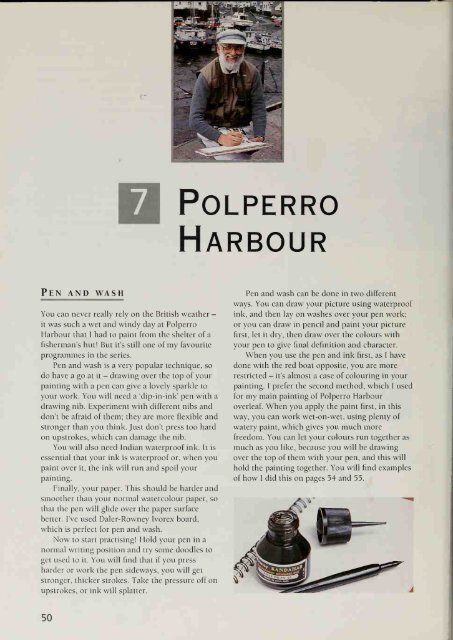A Brush With Art.pdf
You also want an ePaper? Increase the reach of your titles
YUMPU automatically turns print PDFs into web optimized ePapers that Google loves.
cpolperroHarbourPen and washYou can never really rely on the British weather -it was such a wet and windy day at PolperroHarbour that I had to paint from the shelter of afisherman's hut! But it's still one of my favouriteprogrammes in the series.Pen and wash is a very popular technique, sodo have a go at it - drawing over the top of yourpainting with a pen can give a lovely sparkle toyour work. You will need a 'dip-in-ink' pen with adrawing nib. Experiment with different nibs anddon't be afraid of them; they are more flexible andstronger than you think. Just don't press too hardon upstrokes, which can damage the nib.You will also need Indian waterproof ink. It isessential that your ink is waterproof or, when youpaint over it, the ink will run and spoil yourpainting.Finally, your paper. This should be harder andsmoother than your normal watercolour paper, sothat the pen will glide over the paper surfacebetter. I've used Daler-Rowney Ivorex board,which is perfect for pen and wash.Now to start practising! Hold your pen in anormal writing position and try some doodles toget used to it. You will find that if you pressharder or work the pen sideways, you will getstronger, thicker strokes. Take the pressure off onupstrokes, or ink will splatter.Pen and wash can be done in two differentways. You can draw your picture using waterproofink, and then lay on washes over your pen work;or you can draw in pencil and paint your picturefirst, let itdry, then draw over the colours withyour pen to give final definition and character.When you use the pen and ink first, as Idone with the red boat opposite, you are morehaverestricted - it's almost a case of colouring in yourpainting. I prefer the second method, which I usedfor my main painting of Polperro Harbouroverleaf. When you apply the paint first, in thisway, you can work wet-on-wet, using plenty ofwatery paint, which gives you much morefreedom. You can let your colours run together asmuch as you like, because you will be drawingover the top of them with your pen, and this willhold the painting together. You will find examplesof how I did this on pages 54 and 55.50


